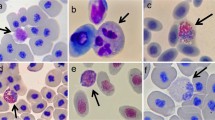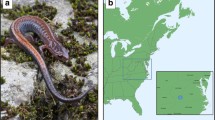Abstract
Metamorphosis in amphibians is a fascinating phenomenon that offers physiologists a number of opportunities to study aspects of tissue growth and lysis in animals. In larval amphibians, tissues are formed early on during larval growth, then are vastly reorganized and broken down during metamorphosis, and the effects of this phenomenon on the relative distribution of white blood cells in circulation (i.e., leukocyte profiles) was first examined in the 1920s. Nearly a century later, there has been little work to continue this research avenue, although our knowledge of the roles of certain leukocyte types has improved. Moreover, recent interest in counts of leukocytes in amphibians for environmental monitoring purposes emphasizes the need to understand how white blood cells naturally vary throughout larval life. In this study, I examined blood smears from wild-caught larval and adult bullfrogs (Rana catesbeiana) of varying developmental stages and quantified the proportions and abundance (estimated from blood smears) of all leukocyte types at each stage. Lymphocytes were the most common cell found and appeared most abundant during the early growth phases of larvae. Neutrophils were the second most common cell and were also associated most with earlier phases. Eosinophils appeared directly associated with metamorphosis, generally increasing in abundance to a peak at metamorphic climax. Monocytes were also found most frequently in individuals experiencing metamorphic climax. Results in this study concerning eosinophils are consistent with those of urodeles and point to their role in the breakdown of tissues, which may resemble their role in modulating inflammation responses.


Similar content being viewed by others
References
Adamko DJ, Odemuyiwa SO, Vethanayagam D, Moqbel R (2005) The rise of the phoenix: the expanding role of the eosinophil in health and disease. Allergy 60:13–22 doi:10.1111/j.1398-9995.2005.00676.x
Barni S, Boncompagni E, Grosso A, Bertone V, Freitas I, Fasola M et al (2007) Evaluation of Rana esculenta blood cell response to chemical stressors in the environment during the larval and adult phases. Aquat Toxicol 81:45–54 doi:10.1016/j.aquatox.2006.10.012
Cabagna MC, Lajmanovich RC, Stringhini G, Sanchez-Hernandez JC, Peltzer PM (2005) Hematological parameters of health status in the common toad Bufo arenarum in agroecosystems of Santa Fe Province, Argintina. Appl Herpetology 2:373–380 doi:10.1163/157075405774483085
Cannon MS, Cannon AM (1979) The blood leukocytes of Bufo alvarius: a light, phase-contrast, and histochemical study. Can J Zool 57:314–322
Cathers T, Lewbart GA, Correa M, Stevens JB (1997) Serum chemistry and hematology values for anesthetized American bullfrogs (Rana catesbeiana). J Zoo Wildl Med 28:171–174
Davis AK, Maerz JC (2008a) Comparison of hematological stress indicators in recently captured and captive paedomorphic mole salamanders, Ambystoma talpoideum. Copeia 2008:613–617
Davis AK, Maerz JC (2008b) Sex-related differences in hematological stress indices of breeding, paedomorphic mole salamanders. J Herpetol 42:197–201 doi:10.1670/06–277R2.1
Davis AK, Cook KC, Altizer S (2004) Leukocyte profiles of House Finches with and without mycoplasmal conjunctivitis, a recently emerged bacterial disease. EcoHealth 1:362–373 doi:10.1007/s10393-004-0134-2
Forbes MR, McRuer DL, Shutler D (2006) White blood cell profiles of breeding American toads (Bufo americanus) relative to sex and body size. Comp Clin Pathol 15:155–159 doi:10.1007/s00580-006-0623-5
Forson D, Storfer A (2006) Atrazine increases ranavirus susceptibility in the tiger salamander, Ambystoma tigrinum. Ecol Appl 16:2325–2332 doi:10.1890/1051-0761(2006)016[2325:AIRSIT]2.0.CO;2
Gervasi SS, Foufopoulos J (2008) Costs of plasticity: responses to desiccation decrease post-metamorphic immune function in a pond-breeding amphibian. Funct Ecol 22:100–108
Gosner KL (1960) A simplified table for staging anuran embryos and larvae. Herpetologica 16:183–190
Hadji-Azimi I, Coosemans V, Canicatti C (1987) Atlas of adult Xenopus laevis laevis hematology. Dev Comp Immunol 11:807–874 doi:10.1016/0145-305X(87)90068-1
Hayes TB (1997) Amphibian metamorphosis: an integrative approach. Am Zool 37:121–123
Hollyfield JG (1966) Erythrocyte replacement at metamorphosis in the frog Rana pipiens. J Morphol 119:1–6 doi:10.1002/jmor.1051190102
Jain NC (1993) Essentials of veterinary hematology. Blackwell, Philadelphia
Jordan HE, Speidel CC (1922) Leukocytes in relation to the mechanism of thyroid-accelerated metamorphosis in the larval frog. Proc Soc Exp Biol Med 20:380–383
Jordan HE, Speidel CC (1923) Blood cell formation and distribution in relation to the mechanism of thyroid-accelerated metamorphosis in the larval frog. J Exp Med 38:529–543 doi:10.1084/jem.38.5.529
Jordan HE, Speidel CC (1924) The behavior of the leucocytes during coincident regeneration and thyriod-induced metamorphosis in the frog larva, with a consideration of growth factors. J Exp Med 40:1–11 doi:10.1084/jem.40.1.1
Kiesecker JM (2002) Synergism between trematode infection and pesticide exposure: a link to amphibian deformities in nature? Proc Natl Acad Sci U S A 99:9900–9904 doi:10.1073/pnas.152098899
Maniatis GM, Ingram VM (1971) Erythropoiesis during amphibian metamorphosis 1. Site of maturation of erythrocytes in Rana catesbeiana. J Cell Biol 49:372 doi:10.1083/jcb.49.2.372
Pfeiffer CJ, Pyle H, Asashima M (1990) Blood cell morphology and counts in the Japanese newt (Cynops pyrrhogaster). J Zoo Wildl Med 21:56–64
Raffel TR, Rohr JR, Kiesecker JM, Hudson PJ (2006) Negative effects of changing temperature on amphibian immunity under field conditions. Funct Ecol 20:819–828 doi:10.1111/j.1365-2435.2006.01159.x
Rollins-Smith LA, Barker KS, Davis AT (1997) Involvement of glucocorticoids in the reorganization of the amphibian immune system at metamorphosis. Dev Immunol 5:145–152 doi:10.1155/1997/84841
Rothenberg ME, Hogan SP (2006) The eosinophil. Annu Rev Immunol 24:147–174 doi:10.1146/annurev.immunol.24.021605.090720
Statistica. 2003. Statistica version 6.1, Statsoft Inc.
Thrall MA (2004) Hematology of amphibians. In: Thrall MA, Baker DC, Lassen ED (eds) Veterinary hematology and clinical chemistry: text and clinical case presentations. Lippincott Williams & Wilkins, Philadelphia, PA
Turner RJ (1988) Amphibians. In: Rawley AF, Ratcliffe NA (eds) Vertebrate blood cells. Cambridge University Press, Cambridge, pp 129–209
Ussing AP, Rosenkilde P (1995) Effect of induced metamorphosis on the immune system of the Axolotl, Ambystoma mexicanum. Gen Comp Endocrinol 97:308–319 doi:10.1006/gcen.1995.1031
Wakahara M, Yamaguchi M (2001) Erythropoiesis and conversion of RBCs and hemoglobins from larval to adult type during amphibian development. Zool Sci 18:891–904 doi:10.2108/zsj.18.891
Wright KM (2001) Amphibian hematology. In: Wright KM, Whitaker BR (eds) Amphibian medicine and captive husbandry. Krieger, Malabar, FL, pp 129–146
Acknowledgments
Jennifer Yates and Stephanie Kern helped with catching adult bullfrogs. John Maerz provided logistic support, and financial support came from the D.B. Warnell School of Forestry and Natural Resources, at the University of Georgia.
Author information
Authors and Affiliations
Corresponding author
Rights and permissions
About this article
Cite this article
Davis, A.K. Metamorphosis-related changes in leukocyte profiles of larval bullfrogs (Rana catesbeiana). Comp Clin Pathol 18, 181–186 (2009). https://doi.org/10.1007/s00580-008-0773-8
Received:
Accepted:
Published:
Issue Date:
DOI: https://doi.org/10.1007/s00580-008-0773-8




